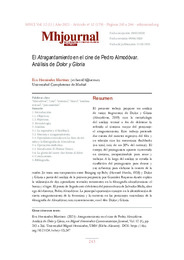Por favor, use este identificador para citar o enlazar este ítem:
https://hdl.handle.net/11000/26374
El Atragantamiento en el cine de Pedro Almodóvar. Análisis de Dolor y Gloria
Título :
El Atragantamiento en el cine de Pedro Almodóvar. Análisis de Dolor y Gloria |
Autor :
Hernández Martínez, Eva |
Editor :
Universidad Miguel Hernández de Elche |
Fecha de publicación:
2021-01-31 |
URI :
http://hdl.handle.net/11000/26374 |
Resumen :
El presente trabajo propone un análisis de varios fragmentos de Dolor y Gloria (Almodóvar, 2019) con la metodología del análisis textual a fin de deletrear lo referido al síntoma mayor del personaje: el atragantamiento. Este trabajo pretende dar cuenta del carácter regresivo del film y su relación con los numerosos flashbacks (en total, más de un 30% del metraje). El cuerpo del protagonista aparece convertido en síntoma, incapacitándole para amar y trabajar. A lo largo del análisis se estudia la conflictiva del protagonista para desear y sus esfuerzos para elaborar la muerte de la madre. Se traza una comparativa entre Bringing up Baby (Howard Hawks, 1938) y Dolor y Gloria a partir del análisis de la primera propuesto por González Requena donde explica la utilización de dos operadores textuales recurrentes en la filmografía almodovariana: el hueso y el tigre. El punto de llegada será el deletreo del primer deseo de Salvador Mallo, alter ego del director, Pedro Almodóvar. La principal aportación consiste en la identificación de cierto atragantamiento de lo femenino y lo materno en los personajes masculinos de la filmografía de Almodóvar; más concretamente, en el film Dolor y Gloria
This work analyzes several sequences from the film Pain and Glory (Almodóvar, 2019) using textual analysis method. Pain notion, which articulates the film, is proposed as a starting point of this analysis. Salvador’s body is a symptom itself, keeping him away from loving and working. Throughout the analysis we are going to study the difficulties of Almodóvar’s alter ego to desire and his great efforts to elaborate her mother’s death. The point of arrival in the analysis will be Salvador Mallo’s first desire, which happens to be different from what the spectator might have thought. This work proposes an analysis of Pain and Glory (Almodóvar, 2019) using textual analysis methodology in order to spell out what refers to the main symptom of the character: choking. This work points out the regressive nature of the film and its relationship with the numerous flashbacks (in total, more than 30% of the footage). Salvador’s body is a symptom itself, keeping him away from loving and working. Throughout the analysis we are going to study the difficulties of Almodóvar’s alter ego to desire and his great efforts to elaborate her mother’s death. A comparison is made between Bringing up Baby (Howard Hawks, 1938) and Pain and Glory from the analysis of the first one proposed by González Requena where he explains the use of two recurring textual operators in Almodovarian filmography: bone and tiger. The point of arrival in the analysis will be Salvador Mallo’s first desire, which happens to be different from what the spectator might have thought. The main contribution consists in the identification of choking with the feminine and the maternal in the masculine characters in Almodovar’s filmography; more specifically, in the film Pain and Glory
|
Palabras clave/Materias:
Almodóvar
cinema
symptom
desire
tex-tual analysis
psychoanalysis |
Área de conocimiento :
CDU: Ciencias sociales |
Tipo documento :
application/pdf |
Derechos de acceso:
info:eu-repo/semantics/openAccess
Attribution-NonCommercial-NoDerivatives 4.0 Internacional |
DOI :
https://doi.org/10.21134/mhcj.v12i.347 |
Aparece en las colecciones:
Miguel Hernández Communication Journal Núm.12 (2021)
|
 La licencia se describe como: Atribución-NonComercial-NoDerivada 4.0 Internacional.
La licencia se describe como: Atribución-NonComercial-NoDerivada 4.0 Internacional.
 La licencia se describe como: Atribución-NonComercial-NoDerivada 4.0 Internacional.
La licencia se describe como: Atribución-NonComercial-NoDerivada 4.0 Internacional.
.png)
